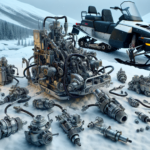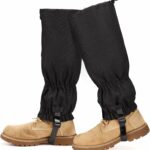You’re about to embark on an exciting journey exploring the world of snowmobiles. Specifically, we’ll unravel the mystery of what fuel type these winter beasts consume. This guide will provide detailed insights, walking you through the fascinating mechanics of snowmobiles and their unique fuel requirements. It’s like lifting the hood of these winter wonder vehicles, offering you a glimpse into the world of snowmobile mechanics. Hold onto your hat, as this ride is about to get interesting.
Understanding Basic Snowmobile Mechanics
Before we delve into the various types of fuels used in snowmobiles, it’s important to understand basic snowmobile mechanics. You’ll appreciate the different fuel choices available if you grasp the working principle along with the significant components of these winter vehicles.
Working principle of a snowmobile
Imagine yourself on a chilly winter night wanting to explore beautiful landscapes covered with fresh white snow. Suddenly, the idea of a snowmobile comes to mind. But how does it work? Well, a snowmobile, also known as a snow machine, operates on a simple mechanism. Typically, it’s powered by either a two-stroke or four-stroke engine. The engine ignites the fuel causing an explosion, which forces the pistons to move. This motion subsequently turns the crankshaft, producing power that drives the track at the rear. The tracks propel the machine forward over the snow-laden ground, giving you an exhilarating ride under the glittering snowfall.
Important components and their functions
Understanding a snowmobile requires knowledge of its vital components and their functions. Some of the main components include the engine, which provides power, the drive belt that transfers power from the engine to the drivetrain, and the skis that support the front half of the snowmobile and help steer it. The track, typically made of rubber and containing raised lugs, propels the snowmobile forward.
Types of Snowmobiles
The fascinating world of snowmobiles isn’t restricted to just one type of machine. There are different types designed to cater to various needs and choices.
Recreational Snowmobiles
Recreational snowmobiles, as the name suggests, are for those who want to have fun in the snow. They’re versatile, user-friendly, and designed for general trail riding.
Utility Snowmobiles
If you need to carry heavy loads or pull a sled across snowy terrain, utility snowmobiles are the way to go. They are robust and durable, designed for work rather than speed or performance.
Touring Snowmobiles
This type is for those who love long thrilling journeys in the snow. Touring snowmobiles typically sport a comfortable two-up seat with a high windscreen, offering additional warmth and protection.
Performance Snowmobiles
For those who crave speed, performance snowmobiles are the right choice. These are often more powerful, offering superior speed and agility.
Crossover Snowmobiles
These snowmobiles offer the best of both worlds, able to handle both trail and off-trail rides. They’re excellent for those who love exploring various terrains yet seek the comfort of tracks.
General Fuel Types Used in Engines
Engines are designed to use different types of fuel, each with its own benefits and downsides. Let’s explore the common ones.
Gasoline
Most engines in the world, especially in the automobile industry, run on gasoline. It’s lightweight, easy to transport, and provides an excellent power-to-weight ratio.
Diesel
Diesel is another common type of fuel used in various engines. Diesel-engined vehicles typically offer better fuel efficiency than their gasoline counterparts. However, diesel is denser and produces more emissions.
Electricity
Electric power is growing in popularity due to its promise of zero-emissions and efficient energy use. However, electric engines usually come with higher upfront costs and charging infrastructure requirements.
Alternative fuels
Alternative fuels like biofuel, hydrogen, and natural gas have gained traction in recent years due to their reduced environmental impact and renewable nature.
Fuel Types Used in Snowmobiles
Like other engines, snowmobobiles also utilize different types of fuel, each affecting the performance and efficiency of the snowmobile differently.
Two-stroke engine fuels
Two-stroke engines mix fuel and oil for lubrication, typically making use of high-octane gasoline.
Four-stroke engine fuels
Four-stroke engines, more common in modern snowmobiles, use separate tanks for oil and fuel, usually unleaded gasoline.
Electric snowmobiles
Electric snowmobiles are an emerging field, which promise zero emissions and quiet operation but currently lack in operational range and require charging infrastructure.
Comparison Between Two-stroke and Four-stroke Engines
Engines play a vital role in a snowmobile’s performance and impact the choice of fuel, hence understanding the difference between two-stroke and four-stroke engines is fundamental.
Differences in structure
The main difference between the two lies in their structure and operating cycle. A two-stroke engine completes its power cycle in two movements, or ‘strokes’, of the piston, while a four-stroke engine takes four.
Differences in fuel efficiency
Four-stroke engines usually offer better fuel efficiency due to their more methodical combustion process.
Differences in power output
Two-stroke engines are usually lighter and can have higher power output, as they produce power with every rotation of the crankshaft.
Differences in environmental impact
Four-stroke engines burn cleaner and produce lesser emissions than two-stroke engines, making them more environmentally friendly.
Factors Influencing Choice of Fuel
When choosing fuel for your snowmobile, there are many factors you need to consider.
Engine type
The type of engine your snowmobile uses determines the choice of fuel. Two-stroke engines use a mix of fuel and oil, while four-stroke engines need separate oil and unleaded gasoline.
Manufacturer’s recommendation
Following your manufacturer’s recommendation is critical, as they best understand the optimal fuel for the machine’s performance and durability.
Availability of fuel
Fuel availability can also influence your choice, particularly in remote areas where certain fuel options might not be easily accessible.
Environmental considerations
If you’re eco-conscious, you would want to go for clean and sustainable fuel options.
How Fuel Type Affects Snowmobile Performance
The type of fuel you use can significantly impact various aspects of your snowmobile’s performance.
Acceleration
Higher quality fuels can improve your snowmobile’s acceleration.
Top speed
Fuel type and quality also influence the top speed. The cleaner the fuel combusts, the smoother the ride becomes, allowing the snowmobile to maintain its top speed more consistently.
Engine lifespan
High-quality fuels burn cleaner and leave fewer residues, which can help prolong engine lifespan.
Maintenance requirements
Using premium-grade fuels can lower your snowmobile’s maintenance requirements by reducing deposit residues and enhancing engine cleanliness.
Environmental Impact of Different Fuel Types
Different fuel types have varying impacts on the environment, and it’s important to understand these effects when choosing a fuel for your snowmobile.
Emission levels of different fuels
Fuels like gasoline and diesel produce high levels of CO2 emissions, which contribute to global warming. On the other hand, electric power produces zero emissions during operation, but the power production itself may still be dependent on fossil fuels.
Climate effects of fuel burning
The burning of fossil fuels releases not only CO2 but also other pollutants like sulfur dioxide and nitrogen oxides, which can harm health and contribute to climate change.
Impact of fuel spills
Fuel spills can contaminate soil and water, affecting local ecosystems and biodiversity.
Exploring Alternative Fuels for Snowmobiles
With increasing awareness of environmental issues, many are exploring alternative fuels for snowmobiles. These alternatives promise less environmental impact and better sustainability without compromising much on performance.
Biofuels
Biofuels, made from organic materials, can reduce CO2 emissions and are renewable, making them an appealing choice.
Hydrogen Fuel
Hydrogen fuel, when used in fuel cell vehicles, only emits water vapour, making it very clean. However, its production and storage pose significant challenges.
Solar Power
While not directly used as a fuel, solar power can charge electric snowmobile battery packs. This method is renewable and produces no emissions, but is dependent on sunlight availability.
Future of Snowmobile Fuels
The future of snowmobile fuels looks promising, with several emerging technologies and the potential for cleaner fuels.
Emerging technologies
Emerging technologies like solid-state batteries can enhance the efficiency and charging times of electric snowmobiles, making them more viable.
Potential switch to cleaner fuels
With increasing pressure to reduce carbon emissions, many are advocating the switch to cleaner fuels. The snowmobile industry will likely see a significant shift in the coming years as these cleaner options become more readily available and affordable.
- What Snowboard Bindings Should I Get? - January 23, 2024
- What Size Screws For Snowboard Bindings? - January 23, 2024
- How To Snowmobile On Water? - January 23, 2024










